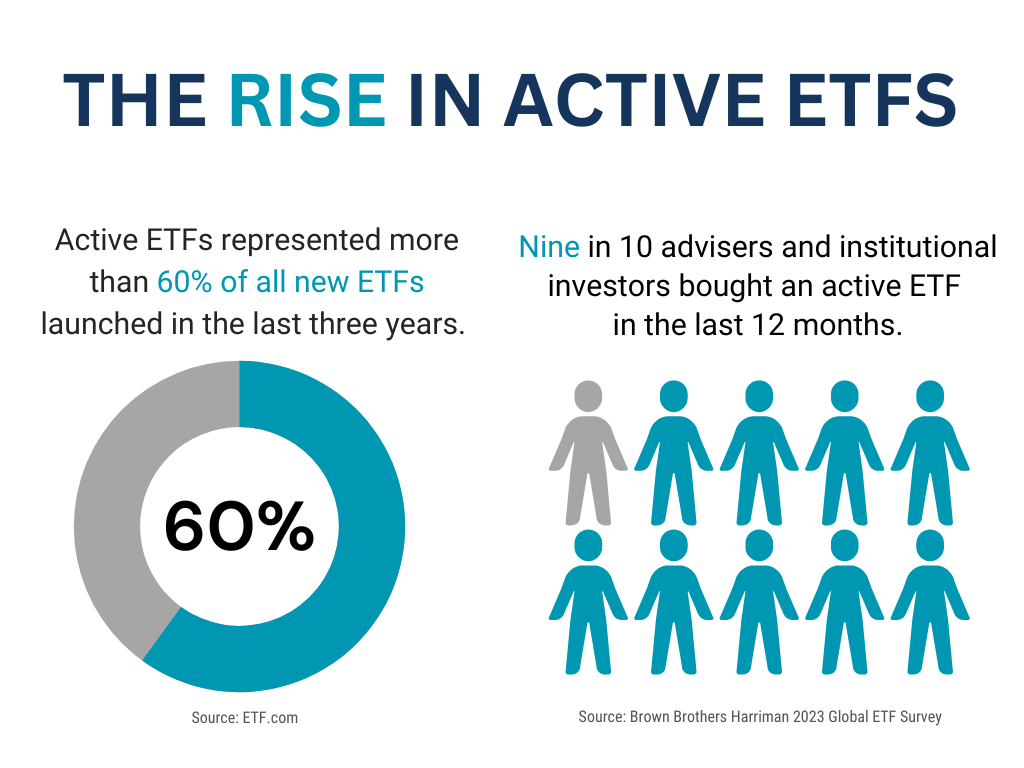Exchange traded funds (ETFs) are evolving. For the last 30 years, almost all ETFs were passively managed, meaning that these ETFs were designed to track a market index, regardless of what happened in the markets or in the world.
In recent years, however, there’s been a striking shift toward actively managed ETFs.
What are active ETFs?
Active ETFs are designed to do more than follow an index. They can chart their own course, using dynamic investment strategies and expert portfolio managers to meet their investment objectives, identify new investment opportunities, and adapt to today’s ever-changing markets.
In a bear market, an active equity ETF can move into less volatile stocks, and when interest rates are rising, an active fixed-income ETF can shift into less interest-rate-sensitive bonds, while a passive ETF is stuck owning the stocks or bonds that make up its particular index. The flexibility of active ETFs has appealed to investors and investment advisers.
The shift to active ETFs
Assets in active ETFs have grown rapidly in recent years from about $50 billion in 2017 to approximately $340 billion by the end of 2022, according to ISS Market Intelligence (ISS MI). In the first quarter of 2023, active ETFs took in $25 billion, nearly a third of all ETF investments.
Nine out of 10 advisers and institutional investors bought an active ETF in the last 12 months, with many advisers moving money out of index and active mutual funds and into active ETFs, according to Brown Brothers Harriman’s 2023 Global ETF Investor Survey, its 10th annual survey of institutional investors, financial advisors, and fund managers.
The number of active ETFs has also increased with active ETFs representing about 60% of all new ETFs launched in the last three years, outpacing new passive (index-based) ETFs.

Are active ETFs the future of ETF investing?
“We think it’s going to be the fastest-growing product type over the next five years,” Christopher Davis, head of fund research at ISS Market Intelligence, told Barron’s in January 2023.
"Active management is likely to drive the next wave of growth for ETFs," the Wall Street Journal wrote in May 2023.
Could active ETFs help you move forward on your investment goals? Here are four reasons to consider adding active ETFs to your portfolio.
4 reasons to invest in active ETFs
1. Tax-efficient active management
Active ETFs can be a good fit for taxable accounts because they give investors the ability to own an actively managed portfolio in the tax-efficient structure of an ETF.
ETFs are generally considered tax-efficient investments because they rarely make taxable capital gains distributions. However, ETF investors will still owe taxes on any capital gains they realize when they sell their shares. Read more about the tax appeal of ETFs here.
2. Unique investment strategies and top portfolio managers
Active ETFs provide access to sophisticated investment strategies and well-known portfolio managers that usually aren’t available through an index ETF. There are active ETFs that specialize in options trading strategies or momentum investing as well as managers who focus on investing in breakthrough technological innovations—to name just a few of the opportunities available in the active ETF space.
Many of these approaches and experts were previously only available to high-net-worth investors, however, since ETFs don’t have minimum investments (most are available per share), active ETFs make these strategies available to nearly everyone.
3. Established track records
While active ETFs may seem like a fairly new part of the ETF world, many active ETF strategies have longer track records than investors might expect.
The first actively managed ETF was introduced 15 years ago in 2008, and there are now more than 60 active ETFs with track records of at least 10 years, according to Morningstar data, a period that includes both bull and bear markets.
Many of the active ETFs with longer track records started out as mutual funds; when the funds were converted into ETFs, the ETFs retained the track records of the predecessor funds. Two of the largest actively managed equity ETFs available today began as mutual funds in 1998.
We've converted our longtime FundX mutual funds into FundX ETFs that have a two-decade history of adapting to changing global market trends.
4. Designed for nearly every part of your portfolio
The first actively managed ETFs were bond ETFs, but the universe of active ETFs has since grown to include hundreds of active ETFs with many different investment objectives. There are actively managed equity ETFs, fixed income ETFs, foreign ETFs, sector ETFs, commodity ETFs, asset allocation ETFs, alternative ETFs, crypto ETFs, and even ETFs of ETFs.
Talk to your adviser about where active ETFs might fit into your investment plans.
